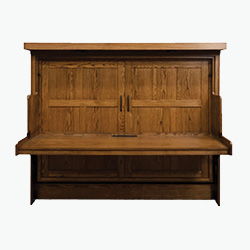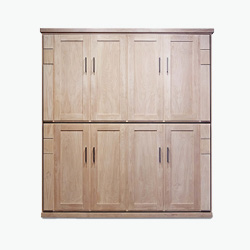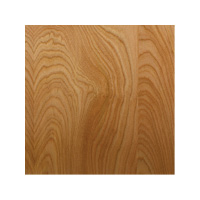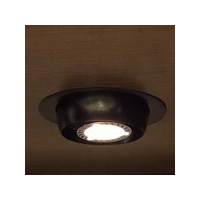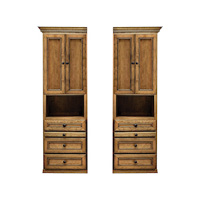Wood and Humidity

Is the type of wood used really make a difference in your Murphy Bed? Yes!
The wood in a Wilding Wallbed is as essential to the durability and function of your wallbed as a uni-body is to the car you drive. It provides the durability to last a lifetime so that you can get the use of the bed that you intend to have with a quality piece of American made furniture. It really does make all the difference in the world to have a quality wood. There is a big separation between the quality wall beds that you’ll get from us, versus what you can typically find from most other wall bed companies.
Looking at our furniture from the outside, you might say, I am sure it looks really simple to select and use the right kind of wood.
Wilding Wallbeds goes the extra mile in their wood selection. In doing this, it’s important to know that there are four major factors that are critical to Wilding Wallbeds when wood selection is made for each bed that is crafted:
1. Kiln Dried lumber
In the wood industry, there are two procedures of removing moisture from wood in a controlled environment. One process is called air drying, the other process is called kiln drying. Kiln drying is much better process of removing moisture from wood. You might not be aware how much it matters to have the wood dried to the proper humidity levels, but here’s why this has an impact on how your bed turns out. Though wood appears to be dry, there is actually a lot of moisture in it, as much as 25% moisture. Literally ¼ of the mass of a board of wood can be water. When a tree is harvested, it stops drawing moisture into it from the ground and the moisture begins to evaporate out of the wood. Depending on the amount of evaporation that occurs and the speed at which that evaporation proceeds is critical to stabilizing that piece of wood. By stabilizing, I mean ensuring that piece of wood will hold the desired shape over a lifetime. Kiln drying is a process where wood is put into a massive oven. These ovens can be as big as 40,000 or 60,000 square feet or even bigger. Heated air is circulated through these ovens. The wood inside the ovens are placed so that air will pass under and over and around the piece of wood, so that all sides of the wood are exposed to the heat. This draws the moisture out of the wood in a way that it stabilizes it. The temperature of the air in the oven and the length of time that the wood is kiln dried has to do with what variety of wood it is. If a company is kiln drying wood for construction purposes it has a different level of tolerance as compared to kiln drying wood for the purpose of furniture construction. Different varieties of wood require different kiln drying times and temperatures. Kiln dried lumber helps Wilding Wallbeds avoid the problems of warping, cupping, bowing, splitting/cracking, checking etc. Wilding Wallbeds accepts only kiln dried hardwoods and plywoods. A piece of wood destined to be a Wilding Wallbed has had the moisture content reduced to only 8%. This has dramatically stabilized that piece of wood. However, there are other factors to consider. If we ship that piece of wood to Arizona or Utah or Nevada or some other arid destination, the moisture content will drop as low as 4%. If that piece of wood is shipped to a humid climate, it may raise to 12% or more. When moisture leaves or enters a piece of wood, it will get larger or smaller. The industry refers to this as shrinking or growing. A board will not grow in length, but will only grow in width, or shrink in width due to that moisture gain or loss. At Wilding Wallbeds, we are very aware of wood and how it reacts, so we are very particular as to what we want in the wood we buy.
2. Lumber Grading
Lumber grading is quite a process and quite an art. Lumber grading is a highly paid occupation as it takes decades of experience to accurately grade wood. Depending on the variety of the wood (by variety, I mean types, like Oak, Alder, Cherry, Maple, etc.), there are multiple wood grades or qualities. The very best pieces of wood in any variety can be referred to as Select or Prime. If a piece of wood does not receive this high grade, it may be referred to as A Grade or Grade 1. There are many grades of wood. The reason that most varieties of wood have different terms in grading is due to forests of wood being located in different areas of the United States. For instance, Furniture quality Alder wood forests are located in the Pacific North West area, while Furniture quality Oak wood forests are located in the northeast portion of the United States. Lastly, wood grading differs when considering the wood is either a solid wood or a plywood. The wood mills that Wilding Wallbeds work with are each highly trained and have reputations of honesty and quality. The Wilding Wallbeds wood purchasing team has great relationships with the mills and supply houses.

3. Engineered Plywood
Trust us, this isn’t as small of a detail as you would assume. The technology that goes into what makes good versus poor plywood has to do with engineering. I mean real engineering. A furniture quality plywood will typically use three different varieties of wood. These specific varieties are chosen for their shape retention during the drying process. They are also chosen because of their ability to flex without cracking or breaking. At this early point in the engineering stage is when you will begin to see a major difference in Wilding Wallbeds plywood and industry standard plywood. You see, we’re building a wallbed which is entirely different than building a dresser or some other piece of wood furniture. A queen size wallbed is 87” tall and 64” wide. When you open a wallbed, the mechanism and wood components are carrying the weight of a queen size mattress, mechanism and bed face and may weigh as much as 260 pounds. By comparison, as you open a drawer in your dresser, you might be moving as much as 25 pounds. Wilding Wallbed’s engineered plywood is a combination of seven layers of specifically chosen wood varieties for the specific purpose of Murphy Bed construction. We don’t just buy standard plywood that is made for general furniture construction, we actually have our wood engineered specifically with Murphy Bed construction in mind. Wood destined to be a Wilding Wallbed needs to be a higher quality than wood that is going to be a dresser or some other case good. Let me explain. Wilding Wallbed’s plywood is built with seven wood layers. The face on both sides will be a solid piece of Oak, Alder, Maple, Cherry, Mahogany or any of the other types of wood we carry. The grain on this piece of wood will run vertically. The next layer, as we move toward the center of the board will also be a solid wood, but the grain will now run horizontally. This process of cross-graining will continue throughout the piece of wood. The purpose of this process of cross graining is to control the growing and shrinking issue. This cross-graining process also successfully addresses the cupping and warping issue. By cross graining the wood it is significantly more stable and can now be built as a Wilding Wallbed with perfect confidence that it will now last a lifetime.
4. Solid Hardwood
It’s easy to assume that an entire bed is made solely of just solid hardwood. But, that’s just not the case. We’ve elected to use the highest grade hardwoods of Oak, Alder, Hard Maple, Soft Maple, Cherry, Poplar and other varieties to use in the vital areas of the construction of the bed. The hardwood pieces will be built out of our finest Oak, Maple, Cherry, Alder, Hickory and Walnut available. The side boards are made from furniture quality plywood. The mattress support deck inner frame is made from a specially designed poplar. Depending on the quality of Wallbed you purchase, the drawers will be built out of Birch plywood or Rustic Cherry hardwood. Wilding Wallbeds are an all wood product, and this is what we hang our hat on.
Because Wilding Wallbeds is an internet based company and ships our product all over America as well as the world, the product is subject to endless humidity, temperature and climatic changes based on where the beds are actually shipped. As we all know, Ontario Canada has different humidity levels than Orlando Florida.We have to plan on those changes in advance. We actually have Wilding Wallbeds on every continent except Antarctica. Each destination has widely varying percentages of humidity. Wood is a natural product and is subject to the moisture in the air as well as heat, cold and barometric pressure. We build our Wallbeds to last a lifetime. We even offer a lifetime guaranty on our product. A company simply can’t offer that type of warranty unless they have the wood under control.
Here are some interesting facts about wood.:
As wood is harvested from a forest, the wood will be 25% or more in moisture content. Moisture evaporates, over time, from any piece of wood. In doing so, the wood may change its shape in any of four major ways,
1. Split/Cracking

I’m sure you’ve seen a 2×4 or some other piece of wood that has cracked due to this moisture loss. It’s much more common to see this problem occur in construction grade wood as the lumber mills will comfortably accept higher residual moisture content in this type of wood. Construction grade wood will ultimately be hidden by wallboard and flooring. Wilding Wallbeds wood will be seen from every side and certainly can’t be cracked in any way.
2. Cupping

Cupping is when a board will bow from side to side, creating a hollow or cupping shape toward the center of the board. I’m sure you’ve seen this too. Cupping occurs when the board harvested comes from very near the actual center grain of the tree. The portion of the board nearest the tree center is tighter and the graining further from the center is larger. The moisture escapes from the larger grain area. So the tighter grain remains tighter and the wider grain in a sense becomes looser and expands. This can produce the cupping issue. Wood that displays this cupping problem simply can’t be used in a Wilding Wallbed.
3. Bowing

Bowing is seen as the wood rises or dips from one end to the other and creates a bow shaped arc. Boards displaying minor bowing can actually still be used. These pieces are cut into shorter sections and planed to be flat, then they are planked side by side with other wood strips to create pieces like drawer fronts or door fronts. It takes the skilled woodworking of Wilding Wallbeds to make these pieces behave over a lifetime.
4. Twist/Torquing.

Lastly, a board can twist or torque, this is where a board has multiple beds in it. As you position yourself at the end of a board and look down its edge, it will wander left, then wander right, then bow up or down. Wilding Wallbeds thinks that a board displaying this issue is not suited for use in a Wilding Wallbed. It’s only good for firewood.
If any of these problems occur in a piece of furniture, it’s a huge problem. When you’re shipping product to such diverse locations, you simply can’t risk a piece of wood that is going to misbehave.
Grading wood, is a process that is done by hand. Each and every board that is purchased by Wilding Wallbeds has been graded at a level that is furniture quality. Additionally, Wilding Wallbeds hand select each piece of wood and determines where it will ultimately fall into the Wallbed construction. We choose the face pieces very carefully as they need to be the most beautiful.
So, though, at first glance, it may seem simple, but I hope you can see now how important the wood selection aspect of Wilding Wallbeds construction is. I hope you can feel our passion and our commitment to turning out a product that you can keep for a lifetime, and one that you will be proud to show to your family and friends too.
 Written by
Written by
Dan Wilding
Marketing Manager

